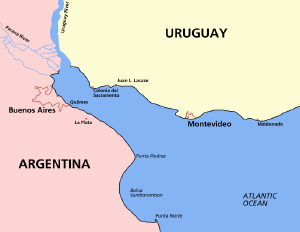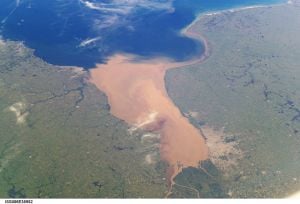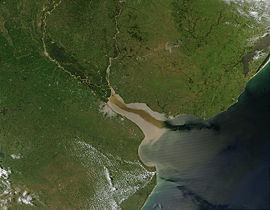Rio de la Plata
The Río de la Plata (Spanish: "Silver River") — which is often referred to in English-speaking countries as the River Plate (as in the Battle of the River Plate), or sometimes as the [La] Plata River — is the estuary formed by the combination of the Uruguay River and the Paraná River. It is a funnel-shaped indentation on the southeastern coastline of South America, extending 290 kilometers (180 mi) from the rivers' confluence to the Atlantic Ocean.
Where the rivers join, it is 48 kilometers (30 mi) wide, and it runs to the southeast growing to 220 kilometers (137 mi) wide where it opens on the Atlantic Ocean, making it the widest estuary in the world. It forms part of the border between Argentina and Uruguay, with the major ports and capital cities of Buenos Aires in the southwest and Montevideo in the northeast. Martín García island, off the coast of Uruguay, is under Argentine sovereignty.
The basin drained by the main tributaries of the Río de la Plata (the Uruguay and Paraná, and the important Paraná tributary, the Paraguay) covers approximately one fifth of South America, including area in southeastern Bolivia, southern and central Brazil, the entire nation of Paraguay, most of Uruguay and northern Argentina. An estimated 57 million cubic metres (2 billion cubic feet) of silt is carried into the estuary each year, where the muddy waters are stirred up by winds and the tides. The shipping route from the Atlantic to Buenos Aires is kept open by constant dredging.
History
The river's first sighting by a European was in 1516, when Spanish seaman Juan Díaz de Solís discovered it during his search for a passage between the Atlantic and the Pacific Oceans. He and a group of his men disembarked in what is today the Uruguayan Department of Colonia and were attacked by the natives (probably Guaraní although for a long time the fact was adjudicated to the Charrúas). Only one of them survived, a 14-year-old cabin boy named Francisco del Puerto, allegedly because the natives' culture prevented them from killing elderly people, women and children.
Years later, from a ship commanded by Sebastián Gaboto, "a huge native making signals and yelling from the coast" was seen; when some of the crew disembarked, they found Francisco del Puerto, brought up as a Charrúa warrior. He went back with the Spaniards and, after some time, returned to Uruguay, leaving no further trace of his whereabouts.
British invasions of the Río de la Plata
The British invasions of the Río de la Plata (Spanish: Invasiones Inglesas al Río de la Plata) were a series of unsuccessful British attempts to seize control of the Spanish colonies located around the La Plata Basin in South America. The invasions took place between 1806 and 1807, as part of the Napoleonic Wars, when Spain was an ally of France.
The invasions were in two phases. A detachment from the British Army occupied Buenos Aires for 46 days in 1806 before being expelled. In 1807, a second force occupied Montevideo, following theBattle of Montevideo (1807), remaining for several months, and a third force made a second attempt to take Buenos Aires. After several days of street-fighting against the local militia in which half of the British forces in Buenos Aires were killed or wounded, the British were forced to withdraw.
The resistance of the local people and their active participation in the defence, with no support from the Spanish Kingdom, were important steps toward the May Revolution in 1810, and the Argentine Declaration of Independence in 1816.
The area was visited by Francis Drake's fleet in early 1578, in the early stages of his circumnavigation. The first European colony was the city of Buenos Aires, founded by Pedro de Mendoza on 2 February 1536, abandoned and founded again by Juan de Garay on 11 June 1580.
An early World War II naval engagement between the German "pocket battleship" (heavy cruiser) Admiral Graf Spee and British ships, the Battle of the River Plate, started several miles off the coast of the estuary. The German ship retired up the estuary and put into port. A few days later, rather than fight she was scuttled in the estuary.
Name
The English name "River Plate" is not a mistranslation, but in fact "plate" was used extensively as a noun for "silver" or "gold" from the 12th century onwards, especially in Early Modern English[1] and the estuary has been known as the River Plate or Plate River in English since at least the time of Francis Drake[2]. A modern translation of the Spanish Río de la Plata is "Silver River", referring not to colour but to the riches of the fabled Sierra del Plata thought to lie upstream.
Fauna
The Río de la Plata is a habitat for the rare La Plata Dolphin, sea turtles (Caretta caretta, Chelonia mydas, and Dermochelys coriacea), and many species of fish.
Footnotes
- ↑ Oxford English Dictionary, 2nd edition, online version.
- ↑ Sir Francis Drake’s Famous Voyage Round the World; A Narrative by Francis Pretty, one of Drake's Gentlemen at Arms
See also
- Government of the Río de la Plata
- Rioplatense Spanish
- Viceroyalty of the Río de la Plata
ReferencesISBN links support NWE through referral fees
- Rela, Walter. España en el Río de la Plata: Descubrimiento y Poblamientos (1516-1588). Montevideo: Club Español. 2001. ISBN 9974-39-317-5.
- Primary sources, with commentary.
- Simionato, Claudia G., Vera, Carolina S., Siegismund, Frank (2005). "Surface Wind Variability on Seasonal and Interannual Scales Over Río de la Plata Area" Journal of Coastal Research. 21 (4): 770-783. Abstract online
External links
- Hydrological report published by the OAS
- Treaty between Uruguay and Argentina concerning the Rio de la Plata and the Corresponding Maritime Boundary (19 November 1973)
- Aquatic Habitat Modifications in La Plata River Basin, Patagonia and Associated Marine Areas
- Water and Land Management on the Uruguayan Coast of the Río de la Plata
- RioPla.com Río de la Plata on-line information (WAP, RSS and WWW): tides, weather, wind. Charts for Garmin GPS.
Credits
New World Encyclopedia writers and editors rewrote and completed the Wikipedia article in accordance with New World Encyclopedia standards. This article abides by terms of the Creative Commons CC-by-sa 3.0 License (CC-by-sa), which may be used and disseminated with proper attribution. Credit is due under the terms of this license that can reference both the New World Encyclopedia contributors and the selfless volunteer contributors of the Wikimedia Foundation. To cite this article click here for a list of acceptable citing formats.The history of earlier contributions by wikipedians is accessible to researchers here:
The history of this article since it was imported to New World Encyclopedia:
Note: Some restrictions may apply to use of individual images which are separately licensed.


